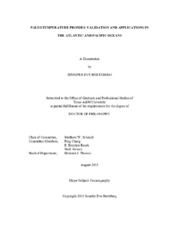| dc.description.abstract | Paleotemperature proxies enable scientists to reconstruct past ocean temperatures from sediment recovered in deep-sea cores. This dissertation takes an in-depth look at two proxies, Mg/Ca ratios of planktonic foraminifera and the TEX86 index, and applies the Mg/Ca paleothermometer in a novel way to assess past changes in tropical Pacific climate.
Chapter II is a reinvestigation of a proposed large salinity effect on Mg/Ca ratios in the foraminifera Globigerinoides ruber based on a recent Atlantic core-top meridional transect study. Shell weight analyses and scanning electron microscopy are used to assess the preservation of similar G. ruber shells used in the core-top study. Shells from the equatorial Atlantic are highly dissolved compared to those from the subtropical gyres, impacting their Mg/Ca-temperatures. When Mg/Ca-temperature calibrations that account for dissolution differences are used, there is no longer an apparent large salinity effect, suggesting that regional differences in preservation, rather than salinity, significantly affect Mg/Ca-temperatures.
Chapter III investigates the TEX86 temperature proxy in the eastern Pacific by utilizing Mg/Ca paleothermometry on multiple species of planktonic foraminifera across the Holocene and Last Glacial Maximum (LGM) to determine the recording depth of the TEX86 proxy. Holocene TEX86 temperatures match sea surface temperatures, but during the LGM, there is a cold bias in TEX86 temperatures that are more representative of the upper thermocline. The best explanation for the offset is a decrease in LGM nutrient availability. Therefore, caution should be applied when interpreting TEX86 records based solely on the relationship between core-top/Holocene TEX86 temperatures and modern observational temperatures.
Chapter IV reconstructs past changes in the tropical Pacific mean state across Marine Isotope Stage 3 by utilizing Mg/Ca paleothermometry on the thermocline dwelling foraminifera Neogloboquadrina dutertrei from an eastern equatorial Pacific sediment core. The thermocline temperature record reveals interstadials are characterized by a more El Niño-like mean state, with increases in thermocline temperatures up to 6°C. Thermocline warming events are more pronounced from 64-44 kyr when global climate was in a warmer state. From 44-32 kyr, the record shows cooler thermocline temperatures, suggesting a shift to a more La Niña-like mean state, as climate began transitioning into the LGM. | en |


